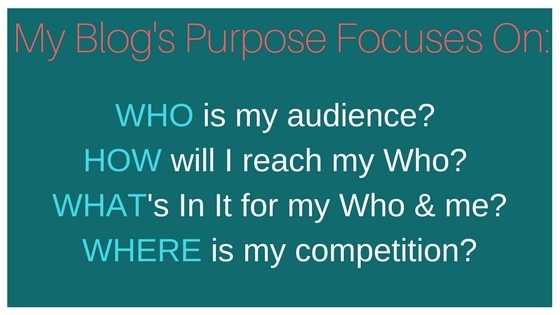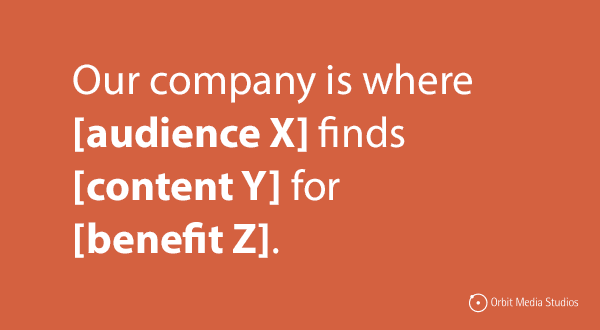
If you're thinking about starting a blog for business, have you considered your purpose for doing so?
For example, are you starting a blog for thought-leadership? Are you looking to build community? Do you want to address customer service issues and how-tos associated with your product or service? Or, are you focused on driving traffic to your website and generating leads for your business?
Your purpose - or your blog's mission statement - will help you determine what kind of content you publish on your business blog, not to mention keep your focus over the long term, so you deliver the right experience for your audience.
By the way, it's a natural to detail that purpose in your 'Welcome Readers' article as you kickoff your blogging strategy! You'll also want to include a succinct version of your purpose in your blog header and in your blog's home page meta description.
The Reality of Blogging for Business
Regardless of your reason for starting a business blog, you'll want think about these realities:
- You'll need to develop content for your blog that someone - beyond your mom and your best friend - will actually want to read and share with others. Think engaging content.
- Your blog will require fresh content on an ongoing basis. Think consistent effort.
- You'll want to publish content that potential readers will be able to find when they start their online research at a search engine window or explore through social channels. Think findable content.
Each reality depends on the others.
Engaging content requires that you know who your audience is. Consistent effort demands a publishing process built around content that is relevant to and compelling for that audience. Finally, findable content means that you've addressed the technical elements of blog writing to make your content stand out in a competitive content marketplace.
What to Consider for your Blog Purpose or Blog Mission Statement?
As with any editorial or content-based mission statement process, you'll want to start with your audience. In other words, the "Who."
Then, explore "How" you plan to reach the "Who."
Identify the "What's In It" for the "Who" and you.
Finally, be sure to understand the "Where" of your competitive environment.

Who are you trying to reach with your business blog?
The most critical part of your purpose is understand who you are trying to reach with your business blog. When you do, you generate traffic which can then lead to subscribers, leads and even prospective customers.
Publishing content on an ongoing basis takes a great deal of time and effort. Figuring out the correct 'who' means that your business will be more likely to support that ongoing investment of resources.
Here's how to identify your blog's audience:
- Look to your business personas. These are semi-fictional representations of your ideal customers based on market research and real data about your existing customers.
- Listen to anyone in your business who directly interacts with customers.
- Think of your in-real-life interactions and which of those are most interested in what your business offers.
As you consider your blog's audience, think intensely about what matters to them, what words they use, what value you can offer them... and how to connect with them as people.
If you don't, no matter how many blog articles - or tweets or Facebook updates - you produce, you won't be successful delivering on the purpose of your blog. Unless you figure out how to connect with your audience, your thought-leadership, community building and website traffic generating efforts will be pointless. Your blog will remain a lonely, standalone digital entity that search engines and visitors will ignore.

How will you reach your audience?
When you consider the 'how' of your blog, you are thinking about the content itself, in other words the voice of your blog, your content topic buckets and the different formats of the article, as well as the business blogging process that helps you stay on track and on schedule.
Blog Voice
Will your blog be casual or formal? Will you be open to questions and comments or only state facts? Will you use first person, second person or third-person only?
Will you focus on educating? On entertaining? On being scientific?
Determine what's right for your audience and your business. You may have several depending on who contributes to your blog.
Content Topic Buckets
Identify broad topics buckets that relate to your business and you are expert in, and that are of interest to your audience. Don't go crazy and try to be all things to all people!
If you need inspiration, think how your favorite magazines organize themselves and notice their common topic buckets.
If there are similiar ones in a same space, look at how one differentiates itself from the other. For example, Fast Company is one of many business-focused publications. It differs by focusing on creativity and innovation.
Article Formats
What formats will your content take?
Certain topic buckets may naturally fall into a specific format. For example, a topic focused on 'voices of the industry' might consist only of blog interviews. Another might be about explaining difficult industry concepts with lots of visuals or video, such as Rand Fishkin's Whiteboard Friday series.
>> See Blog Post Ideas: Maximize Your Reach with the Right Topics - Whiteboard Friday
It's a good idea to have several formats you're comfortable with for your blog for variety and interest.
The Business Blogging Process
A business blog is particularly effective at generating traffic by virtue of regular and consistent publishing. That means having a schedule and sticking to it, just as a daily newspaper, a weekly digest or monthly publication does.
Winging it goes so far. You also want to avoid burnout.
Best, then, to have a content calendar whereby you identify ahead of time topics to cover, specific articles to develop and due dates for delivery.
Also consider how to amplify each article once it is live through distribution to social media outlets, as well as in your own email and other business communication tools.
>> See Steve Rubel Talks Inbound Content Challenges at #INBOUND15 who describes connecting the dots as Walt Disney did to broaden the reach of your content.
What's in it for your audience? What you want from them?
It's really easy to lose sight that your audience has plenty of other options besides reading your blog article.
So, what' in it for them? What benefits will they gain from your prose? How will you help them?
At the same time, since you're in business, you have to think about what you want from them... Yes, you'd like them to read your content. But, what else?
- Is it to engage with your content through comments?
- What about subscribing to your blog?
- Do you want readers to download a content offer?
- Are you trying to build relationships (and links) with influencers in your industry?
If what you offer them is of sufficient value, you may receive what you want from them.
Where is your competition?
When you're getting started with a blog, it can be overwhelming to think about who else is out there writing competitive content.
At the same time, it's both humbling and grounding to do research on the keywords and topics that you intend to focus on.
- What if your most important concept makes sense when you are speaking one-on-one with someone, but doesn't translate in a Google search?
- What if there's nothing new to say about your topics?
- What if your competitors are already there?
None of this means you shouldn't launch your business blog. Quite the opposite!
It will affect, though, affect your purpose.
So, research your keywords and topics. Find out who else is writing about them and how authoritative their sites are. Get creative about how to make your content more relevant to your audience and your site more authoritative about your subject matter.
>> See How Media Relations Can Drive SEO For Business
Verbalizing Your Blog's Purpose
Since you've done all this good work, you can now verbalize what your blog and its purpose are about and use it to energize you and your blog team, and stay focused.
In case you need more, here are two resources that detail the creation of a content or blog mission statement. I find that having several related visuals to refer to helps crystalize my thinking.
1. From Orbit Media, How to Create a Content Mission Statement with 4 Simple Templates

2. From Allyssa Barnes, Why You Absolutely Need a Blog Mission Statement (and How to Create One)

Inspiration for Being Purposefully Remarkable in Your Business Blogging Content
Finally, if you truly want to be remarkable in your blogging content creation, be sure to pay close attention to MarketingProf's intensely inspiring Ann Handley.
>> See 5 Keys To Developing A Strong Tone of Voice in Your Content Marketing
>> See Ann Handley: Sorry Did You Say Something? The Future of Content is Writing [#CMWorld Recap]
Are you ready now to start your business blog? What's your purpose?
Let me know in the comments what your business blog purpose is.
This article was originally published Dec. 1, 2011 and has been updated to be more remarkable.








